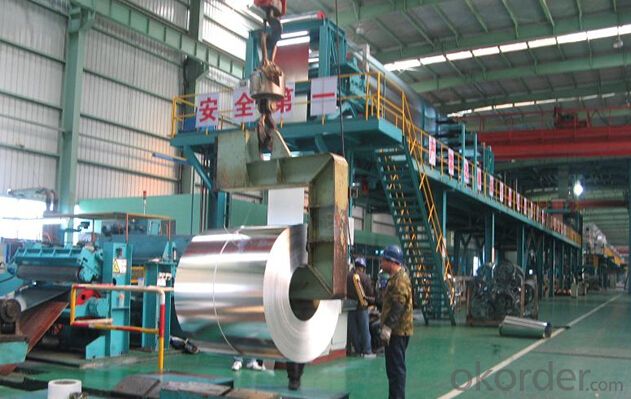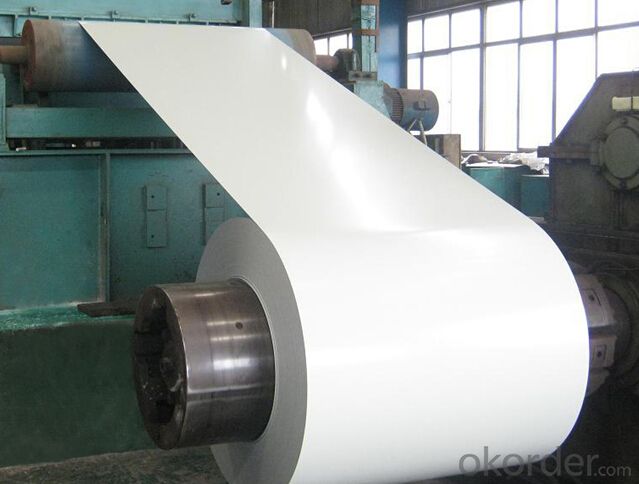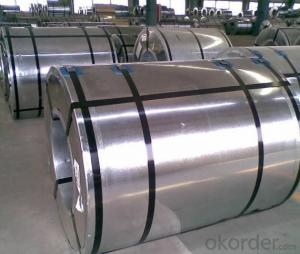Galvanized Steel Coil (DC51D+Z, DC51D+ZF (St01Z, St02Z, St03Z)) Type: Punching Steel
- Loading Port:
- Tianjin
- Payment Terms:
- TT OR LC
- Min Order Qty:
- 25 m.t.
- Supply Capability:
- 10000 m.t./month
OKorder Service Pledge
OKorder Financial Service
You Might Also Like
Basic Info.
Model NO.:DC51D+Z, DC51D+ZF (St01Z, St02Z, St03Z)
Surface Treatment:Galvanized
Technique:Cold Rolled
Standard:ASTM,JIS,GB,AISI,DIN,Bs and Others
Steel Grade:DC51d+Z,DC51d+Zf (St01z,St02z,St03z)
Export Markets:Global
Additional Info.
Trademark:AIYIA GROUP
Packing:Seaworthy Package
Standard:PRIME QUALITY
Origin:Made in China
HS Code:72103000
Production Capacity:5000tons Per Month
Product Description
Brief Introduction:
Commodity name : Prepainted Dipped Galvanized Steel Coil
Standard we can provide: AISI ASTM BS DIN GB JIS
Grade : DC51D+Z,DC51D+ZF,St01Z,St02Z,St03Z
Zinc Coating:40g-275g/m2
Color: By RAL NO.
Size we can provide:
Size Range: CRC substrate Thickness: 0.3-3.0mm
CRC substrate Width: 800-1830mm
HRC substrate Thickness:1.8-5.0mm
HRC substrate Width:900-1500mm


FAQ
1.What's your MOQ?
25MT, it is for one container.
2.Do you have QC teams?
Yeah, sure, our QC team is very important, they will keep the quality control for our products.
3. What's your normal delivery time?
Our delivery time about 10-20days for standard sizes, if you have other requirements like hardness and width ,it is about 20-40days. But don't worry ,we also try our best for the delivery time ,because time longer and our cost is higher.
4.Are the products tested before shipping?
Yes, all of our PPGI and GI was qualified before shipping. We test every batch every day.
- Q:What are the different types of edge treatments for steel coils?
- There are several different types of edge treatments for steel coils, each serving a specific purpose and providing different benefits. 1. Slit Edge: Slit edge is the most common type of edge treatment for steel coils. It is achieved by cutting the coil along its width, resulting in two distinct edges. Slit edges are generally smooth and free from burrs, making them suitable for most applications. 2. Mill Edge: Mill edge is the untreated edge of a steel coil as it comes from the rolling mill. It is characterized by a rough and uneven surface, with visible imperfections such as burrs and irregularities. Mill edges are typically not suitable for direct use and require further processing or trimming to achieve a desired edge quality. 3. Trimmed Edge: Trimmed edge is an edge treatment that involves removing the rough and irregular portions of the mill edge. This process is done through shearing or cutting, resulting in a smoother and more consistent edge. Trimmed edges are commonly used when a clean and uniform appearance is required. 4. Deburred Edge: Deburring is a process that removes any sharp or rough edges from the steel coil. This treatment is essential for applications where safety is a concern, as it eliminates the risk of injury from handling sharp edges. Deburred edges are achieved through grinding or filing and provide a smooth and safe edge for various applications. 5. Rounded Edge: Rounded edge is a type of edge treatment that involves rounding the sharp corners of the steel coil. This treatment is often used to prevent damage to other materials or surfaces during handling or transportation. Rounded edges reduce the risk of scratches, dents, or other forms of surface damage. 6. Beveled Edge: Beveled edge is an edge treatment where the edge of the steel coil is cut at an angle, typically 45 degrees. This type of treatment is commonly used in applications that require a tight fit or seamless joint with other components. Beveled edges allow for easier assembly and improve the overall appearance of the final product. Each of these edge treatments has its own advantages and is chosen based on the specific requirements of the application. The selection of an appropriate edge treatment for steel coils is crucial to ensure optimal performance, safety, and aesthetics in various industries such as construction, manufacturing, automotive, and more.
- Q:I have a tiara and it oxidized and I'm not sure what material it is. I know it it isn't metal so i was wondering if is steel? Also if it's steel, can I do something to clean it?
- Yes - Steel can oxidize, its most commonly called rust Steel is a metal. Depending on the level of oxidation, you might be able to polish it with very fine steel wool. If is is really bad, then you might need a chemical cleaner such as Naval Jelly, which can be found at the hardware store. But the Naval Jelly might discolor the metal, so then you might need to polish it afterward to return its finish.
- Q:What are some of the greatest steel guitar songs in the history of country music. Western swing applies also.
- Bob okorder /
- Q:What are the different coating options for steel coils?
- There are several coating options available for steel coils, each serving different purposes and providing unique benefits. Some of the commonly used coating options for steel coils include: 1. Galvanized Coating: This coating involves immersing the steel coils in a bath of molten zinc, creating a layer of zinc on the surface. Galvanized coating provides excellent corrosion resistance and protects the steel from rusting. It is commonly used in applications where the steel coils are exposed to harsh environments or moisture. 2. Galvannealed Coating: This coating is a combination of galvanizing and annealing processes. The steel coils are first galvanized and then annealed to create a layer of zinc-iron alloy on the surface. Galvannealed coating offers enhanced paintability and weldability while providing good corrosion resistance. 3. Aluminum-Zinc Alloy Coating: Also known as Galvalume, this coating consists of an aluminum-zinc alloy applied to the steel coils. It provides excellent corrosion resistance and heat reflectivity, making it suitable for various applications, including roofing, siding, and automotive parts. 4. Organic Coatings: These coatings are typically applied as a top layer over a base coat of galvanized or galvannealed coating. Organic coatings can be in the form of paints, lacquers, or powder coatings. They provide additional protection against corrosion, UV rays, and abrasion, while also enhancing the aesthetics of the steel coils. 5. Chromate Conversion Coating: This coating is primarily used as a pre-treatment before applying organic coatings. It helps improve adhesion between the steel surface and the organic coating, ensuring better corrosion resistance. The choice of coating depends on various factors such as the intended application, environmental conditions, desired appearance, and budget. Manufacturers and end-users should carefully consider these factors to select the most suitable coating option for their specific requirements.
- Q:How are steel coils used in the production of aerospace parts?
- Steel coils are used in the production of aerospace parts as they provide a reliable and durable material for manufacturing various components such as engine parts, structural beams, and landing gear. The coils are first processed and shaped into specific forms and sizes, then undergo further fabrication processes like cutting, welding, and machining to create the desired aerospace parts. The high strength and corrosion resistance of steel make it an ideal choice for ensuring the safety and performance of aerospace components.
- Q:What are the common coil thicknesses available for steel coils?
- The common coil thicknesses available for steel coils range from 0.15mm to 25mm, depending on the specific requirements and applications.
- Q:I thought it was STAINLESS STEEL! I have stainless steel can openers spatulas that are rusty. What's up with that? did you know that braces on people's teeth are made of stainless steel? That's why they call people metal-mouth. I used to have braces.
- You can rub the rust off with anything, from steel wool to Ajax. Although if you've previously used steel wool to clean it, that could be why it rusts. We had that problem manufacturing stainless steel railing and had to put it together on an aluminum table and polish welds with grinding wheels that never touched steel. What rusts are steel particles picked up on the stainless surface. Another possibility is that some stainless is more magnetic and usually also heat-treatable. It has just enough chrome in it to classify as stainless but can get minor surface rust. Not nearly as much as plain steel, though. Use a scouring powder like Zud or Barkeepers Friend and a cloth or sponge to polish if it's a sheetmetal surface rather than a bar grille, because these have oxalic acid and no bleach. They don't leave corrosive traces of chlorine behind. In fact, oxalic acid reduces rust to iron powder. Which is really neat if you need to clean a small rusty item--stir one of these powders into water, drop in the rusty piece and check it from time to time. Rinse off any abrasive powder, dry it well and oil it. When the rust is gone, it leaves a fine matte finish behind.
- Q:Why?Which one should i get? I am just starting to learn Guitar. Which one would be better for me? What is the difference? I already got the acoustic nylon but i might return it... if the steel is better.
- I find for beginners nylon is better. You won't get as many blisters and nylon strings are easier to bend. Check out my website for some free lessons and free bonus info for the exact answer you are looking for
- Q:How are steel coils used in the manufacturing of structural components?
- Steel coils are used in the manufacturing of structural components by being processed and formed into various shapes such as beams, columns, and plates. These coils are first uncoiled and then cut into desired lengths before being shaped and welded together to create strong and durable structural components used in buildings, bridges, and other infrastructure projects.
- Q:What are the main steel coil producing countries?
- The main steel coil producing countries are China, Japan, India, the United States, and Russia.
1. Manufacturer Overview |
|
|---|---|
| Location | |
| Year Established | |
| Annual Output Value | |
| Main Markets | |
| Company Certifications | |
2. Manufacturer Certificates |
|
|---|---|
| a) Certification Name | |
| Range | |
| Reference | |
| Validity Period | |
3. Manufacturer Capability |
|
|---|---|
| a)Trade Capacity | |
| Nearest Port | |
| Export Percentage | |
| No.of Employees in Trade Department | |
| Language Spoken: | |
| b)Factory Information | |
| Factory Size: | |
| No. of Production Lines | |
| Contract Manufacturing | |
| Product Price Range | |
Send your message to us
Galvanized Steel Coil (DC51D+Z, DC51D+ZF (St01Z, St02Z, St03Z)) Type: Punching Steel
- Loading Port:
- Tianjin
- Payment Terms:
- TT OR LC
- Min Order Qty:
- 25 m.t.
- Supply Capability:
- 10000 m.t./month
OKorder Service Pledge
OKorder Financial Service
Similar products
New products
Hot products
Related keywords



























